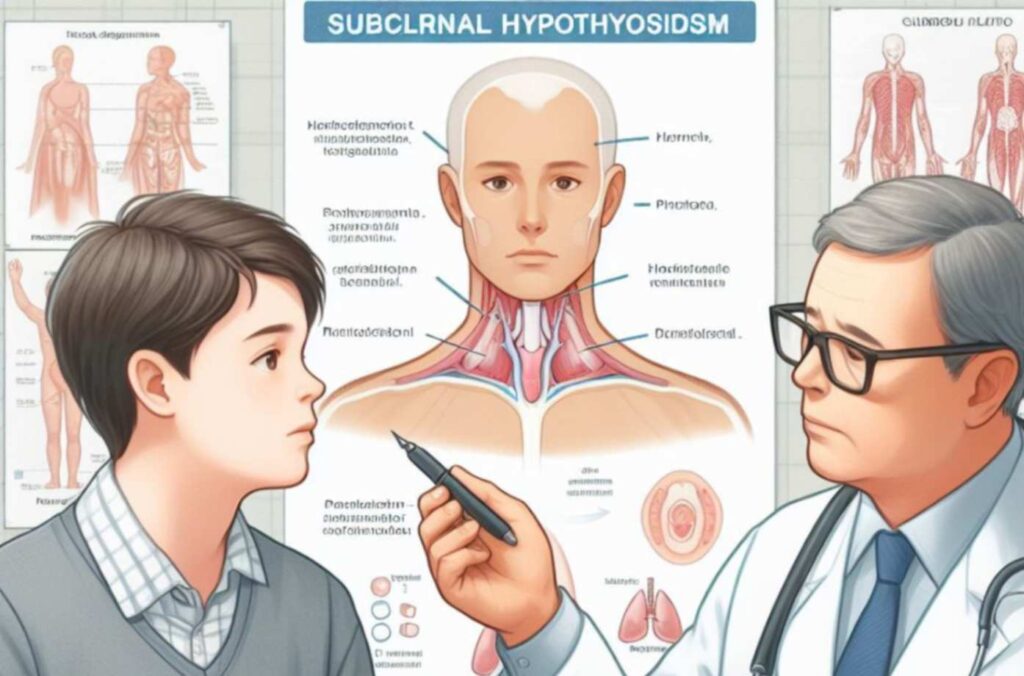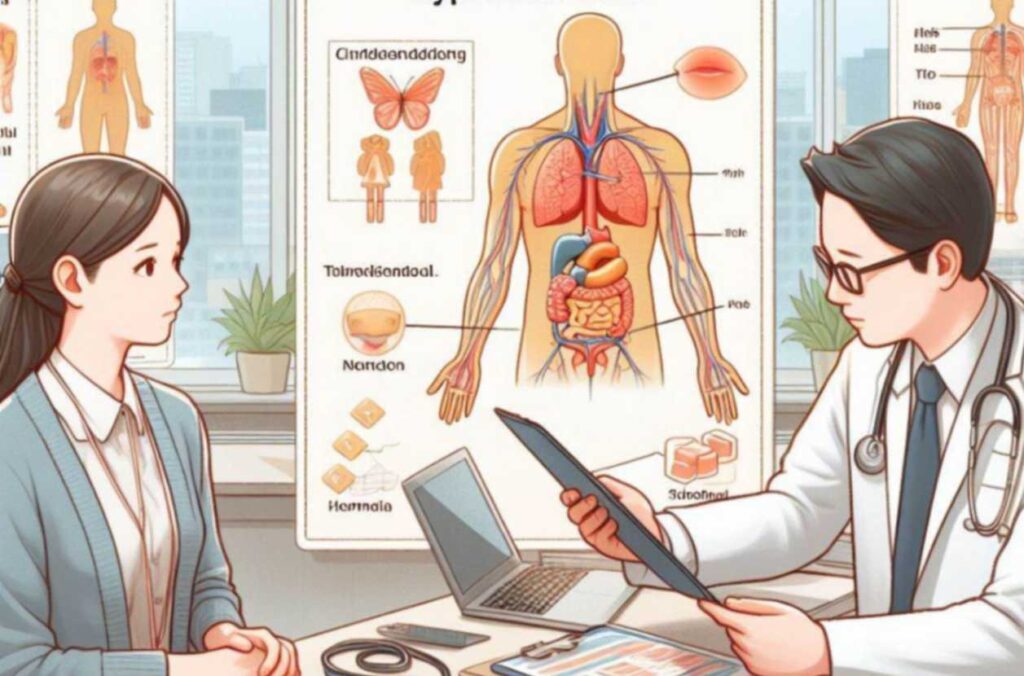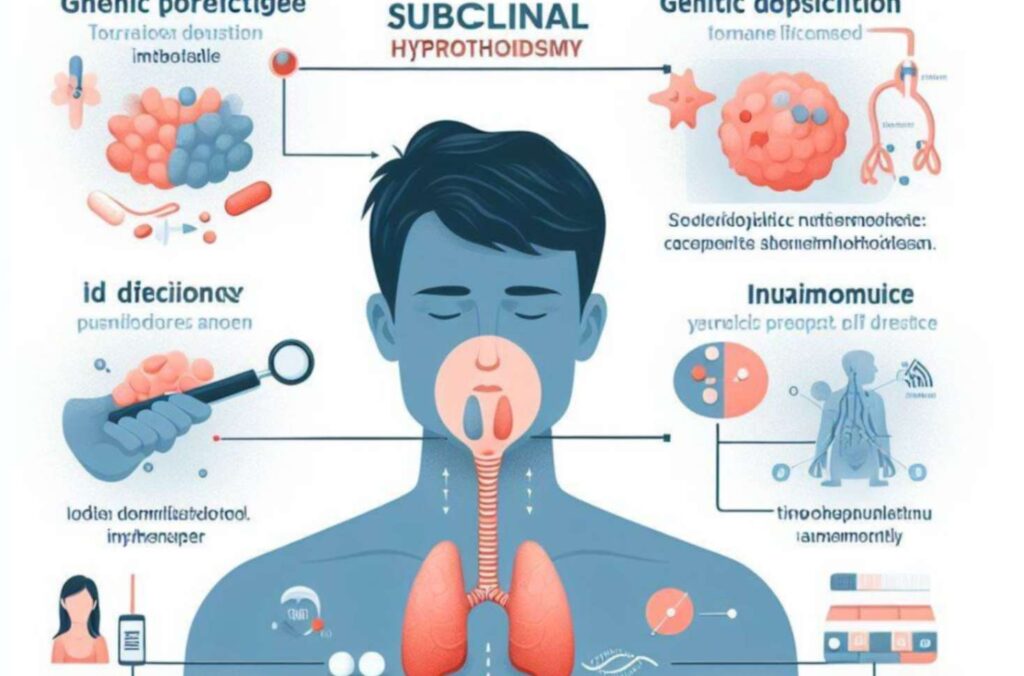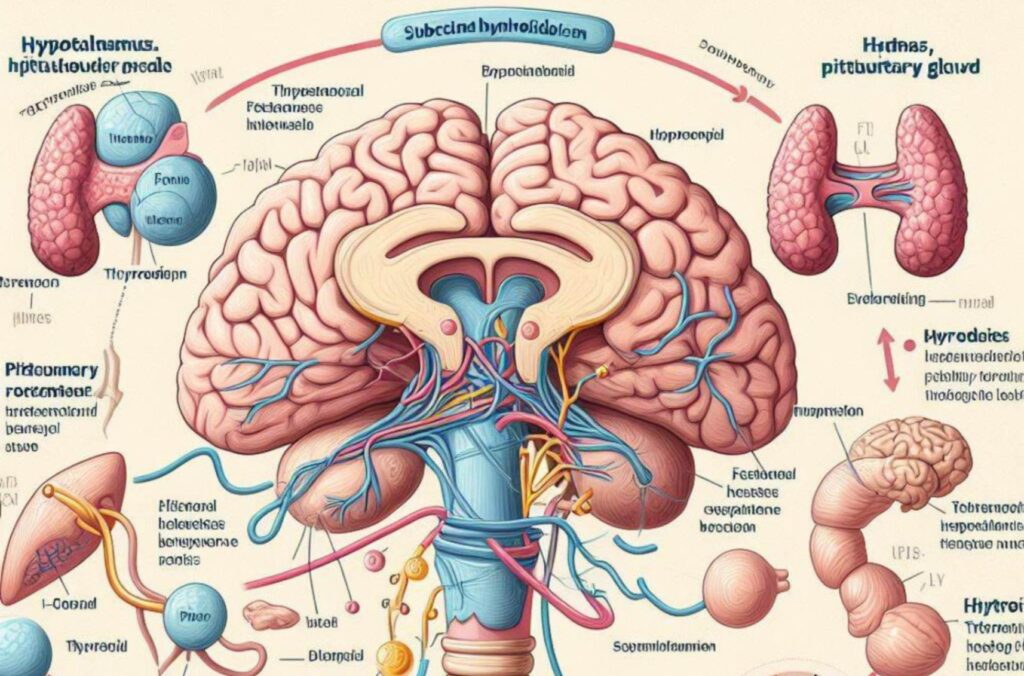A mild thyroid condition known as clinical hypothyroidism is characterized by increased TSH levels combined with normal free T4 and T3. It affects up to 10% of the population without conventional symptoms, particularly in elderly persons and women. Early detection is critical, as untreated cases can progress to hypothyroidism, which can lead to serious health problems. This article discusses its symptoms, diagnosis, and management, offering key insights into this commonly overlooked condition.
Causes and risk factors:
1. Primary Causes:
Hashimoto’s thyroiditis, or autoimmune thyroiditis:
Hashimoto’s thyroiditis has a major impact on subclinical hypothyroidism. An autoimmune disease arises when the thyroid gland is unintentionally targeted by the immune system. This causes the thyroid tissue to gradually deteriorate and to remain inflamed over time. As a result, the gland’s capacity to create thyroid hormones is gradually diminished, which causes the body to attempt compensatory production of increased TSH levels.

Iodine deficiency or excess:
Thyroid hormone synthesis requires iodine. TSH levels may rise as a result of insufficient hormone synthesis brought on by inadequate iodine intake. Then again, an over-the-top utilization of iodine may possibly impede thyroid capability, prompting subclinical hypothyroidism through the potential for an immune system response or thyroiditis.
2. Secondary causes:
Medicines:
Certain medications may have an effect on thyroid function. Drugs used to treat bipolar disorder and antiarrhythmics such amiodarone and lithium can affect thyroid hormone synthesis and metabolism. Thyroid dysfunction may arise from these drugs because they may alter the way iodine is used or have a direct effect on thyroid cells.
Radiation Therapy:
Thyroid gland damage can result from radiation therapy, particularly in cases of head and neck cancer. Subclinical hypothyroidism brought on by this lesion may lessen the gland’s capacity to produce thyroid hormones. This is more likely to happen to those who were exposed to high radiation dosages as children.
Pituitary or Hypothalamic Dysfunction:
Subclinical hypothyroidism may result from problems with the pituitary or hypothalamus. The regulation of thyroid function is significantly influenced by these brain regions. Thyroid hormone synthesis may be hampered by any disturbance in their function that leads to insufficient generation of TSH or TRH (thyrotropin-releasing hormone).
3. Risk factors:
Genetic predisposition:
Subclinical hypothyroidism is more likely to occur if there is a family history of thyroid issues. This risk is largely influenced by genetic factors, as some genes are linked to a higher chance of developing autoimmune thyroid illnesses.
Age and gender considerations:
Subclinical hypothyroidism is more prevalent in women and elderly persons. Hormonal fluctuations raise the risk, particularly during menopause. Additionally, aging can cause a gradual decline in thyroid function, making older adults more susceptible.
Understanding the causes and risk factors of subclinical hypothyroidism is essential for early detection and management. By identifying these characteristics, medical professionals can avoid the progression of hypothyroidism by identifying patients who are at risk and implementing appropriate therapies.
Pathophysiology:
1. Basics of Thyroid Function:
Thyroid hormone production:
Triiodothyronine (T3) and thyroxine (T4), two hormones necessary for metabolism and other body functions, are produced by the thyroid gland.
Regulation by the HPT axis:
The hypothalamic-pituitary-thyroid (HPT) axis regulates the synthesis of thyroid hormones. Thyrotropin-releasing hormone (TRH), which is released by the hypothalamus, causes the pituitary gland to release thyroid-stimulating hormone (TSH), which in turn causes the thyroid gland to release T4 and T3.

2. Mechanism of subclinical hypothyroidism:
TSH levels that are raised:
TSH levels that are elevated in subclinical hypothyroidism indicate insufficient thyroid hormone synthesis even in the presence of normal free T4 and T3 levels.
Disruption of feedback mechanisms:
Hormone homeostasis is preserved through the HPT axis feedback loop, which is disturbed. In an attempt to activate the thyroid gland, the pituitary gland produces more TSH when thyroid hormone levels are low.
Progression To overt Hypothyroidism:
Factors leading to progression:
From hypothyroidism, as evidenced by subclinical levels that were observed, high initial TSH, and primary autoimmunity.
Thyroid function monitoring:
To identify the development of overt hypothyroidism in people with subclinical hypothyroidism, routine thyroid function monitoring, including recurring TSH and free T4 testing, is essential.
Symptoms and clinical presentation:
1,Asymptomatic nature:
Many people with subclinical hypothyroidism have no noticeable symptoms, making it difficult to detect without routine blood tests. Elevated TSH levels are often found during screening for other health problems.
2. Mild symptoms:
Some people may have modest symptoms like weight gain, weariness, and cold intolerance. It’s also possible for subtle cognitive changes to happen, including trouble concentrating. These signs are frequently vague and simple to ignore.

3. Symptom Variability:
Symptoms differ greatly from person to person. Age, gender, and general health are among the variables that impact presentation. While younger persons may detect changes in weight or energy levels, older adults may notice changes in cognitive function.
Early detection and therapy of subclinical hypothyroidism depend on an understanding of its symptoms and clinical presentation. The progression of hypothyroidism can be halted with regular awareness and monitoring. Acknowledging differences enables medical professionals to deliver individualized care.
Assessment:
1. Laboratory Testing:
Blood testing determine the subclinical hypothyroidism diagnosis. This condition is confirmed by an increased TSH level along with normal free T4 and T3 levels. Testing on a regular basis aids in tracking thyroid function over time.
2. Diagnostic Standards:
A TSH level that is higher than normal yet free T4 and T3 levels are normal is referred to as subclinical hypothyroidism. A TSH cutoff is specified by clinical guidelines in order to distinguish between overt and subclinical hypothyroidism.
3. Distinctive diagnosis:
It is crucial to rule out other illnesses that mimic thyroid insufficiency. A thorough medical history, physical examination, and other testing aid in differentiating subclinical hypothyroidism from other medical conditions.
Read More About 5 Warning signs of bladder cancer.
Conclusion:
A prevalent and sometimes disregarded disease called subclinical hypothyroidism is characterized by increased TSH levels with normal thyroid hormone levels. In order to recognize it early and treat it effectively, it is crucial to comprehend its etiology, risk factors, pathophysiology, and clinical presentation.

Crucial actions include routine blood testing for monitoring, being mindful of minor symptoms, and distinguishing the illness from other medical issues. An accurate diagnosis combined with careful monitoring can stop the progression of hypothyroidism, improving the quality of life and health outcomes for those who are impacted.
FAQs:
What are the common symptoms of subclinical hypothyroidism?
Many people have no symptoms. Some may feel tired, gain weight, or have trouble concentrating.
How is subclinical hypothyroidism diagnosed?
It is diagnosed by blood tests that show high levels of TSH but normal free T4 and T3 levels.
Related:
Which of these is not Important for Positive Mental Health?
Mental health is the foundation of a happy and balanced life. It is influenced by…
What is Commonly Misdiagnosed as Pink Eye?
Pink eye, or conjunctivitis, is a common eye problem. It causes redness, itching and sometimes…


